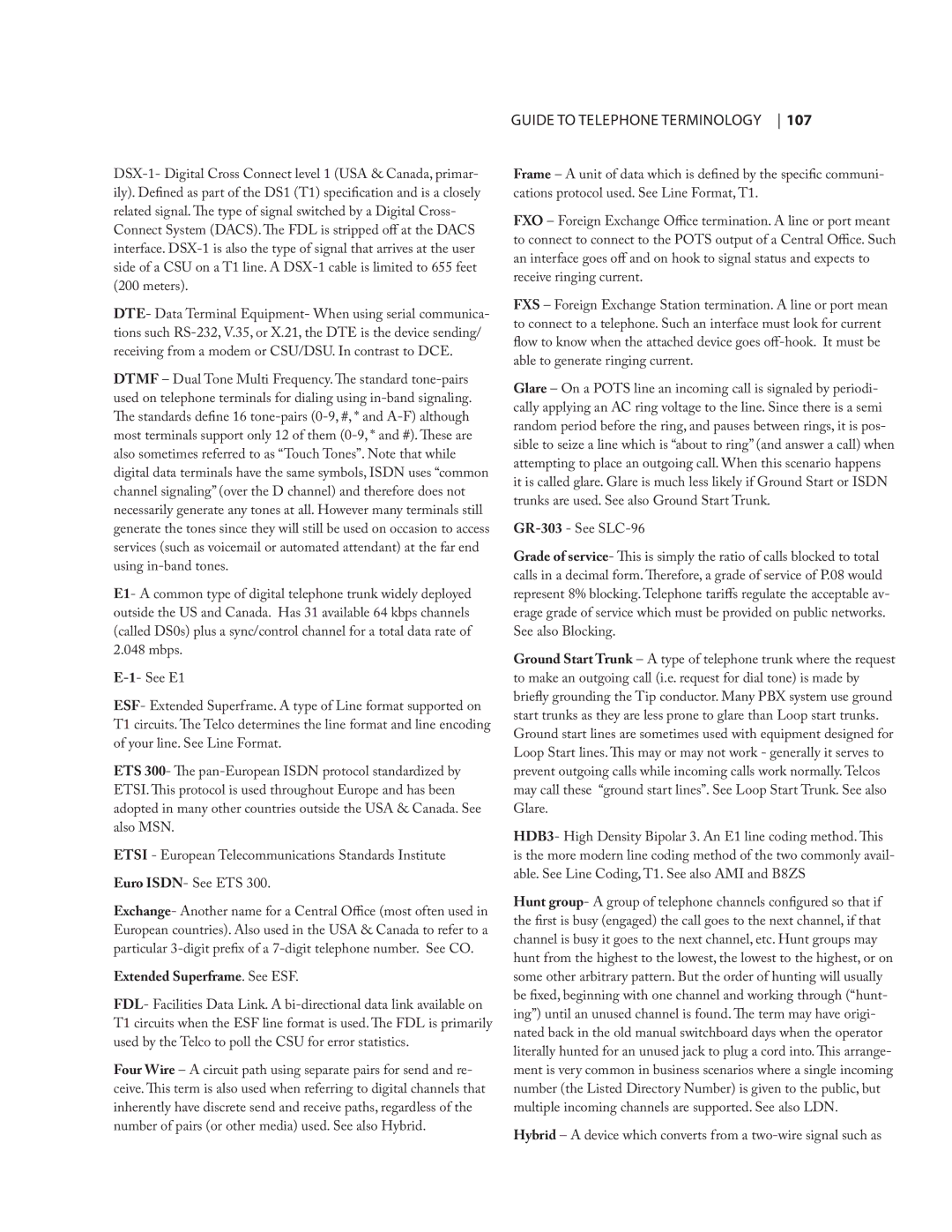guide to telephone terminology 107
DTE- Data Terminal Equipment- When using serial communica- tions such
DTMF – Dual Tone Multi Frequency. The standard
E1- A common type of digital telephone trunk widely deployed outside the US and Canada. Has 31 available 64 kbps channels (called DS0s) plus a sync/control channel for a total data rate of 2.048 mbps.
ESF- Extended Superframe. A type of Line format supported on T1 circuits. The Telco determines the line format and line encoding of your line. See Line Format.
ETS 300- The
ETSI - European Telecommunications Standards Institute Euro ISDN- See ETS 300.
Exchange- Another name for a Central Office (most often used in European countries). Also used in the USA & Canada to refer to a particular
Extended Superframe. See ESF.
FDL- Facilities Data Link. A
Four Wire – A circuit path using separate pairs for send and re- ceive. This term is also used when referring to digital channels that inherently have discrete send and receive paths, regardless of the number of pairs (or other media) used. See also Hybrid.
Frame – A unit of data which is defined by the specific communi- cations protocol used. See Line Format, T1.
FXO – Foreign Exchange Office termination. A line or port meant to connect to connect to the POTS output of a Central Office. Such an interface goes off and on hook to signal status and expects to receive ringing current.
FXS – Foreign Exchange Station termination. A line or port mean to connect to a telephone. Such an interface must look for current flow to know when the attached device goes
Glare – On a POTS line an incoming call is signaled by periodi- cally applying an AC ring voltage to the line. Since there is a semi random period before the ring, and pauses between rings, it is pos- sible to seize a line which is “about to ring” (and answer a call) when attempting to place an outgoing call. When this scenario happens it is called glare. Glare is much less likely if Ground Start or ISDN trunks are used. See also Ground Start Trunk.
Grade of service- This is simply the ratio of calls blocked to total calls in a decimal form. Therefore, a grade of service of P.08 would represent 8% blocking. Telephone tariffs regulate the acceptable av- erage grade of service which must be provided on public networks. See also Blocking.
Ground Start Trunk – A type of telephone trunk where the request to make an outgoing call (i.e. request for dial tone) is made by briefly grounding the Tip conductor. Many PBX system use ground start trunks as they are less prone to glare than Loop start trunks. Ground start lines are sometimes used with equipment designed for Loop Start lines. This may or may not work - generally it serves to prevent outgoing calls while incoming calls work normally. Telcos may call these “ground start lines”. See Loop Start Trunk. See also Glare.
HDB3- High Density Bipolar 3. An E1 line coding method. This is the more modern line coding method of the two commonly avail- able. See Line Coding, T1. See also AMI and B8ZS
Hunt group- A group of telephone channels configured so that if the first is busy (engaged) the call goes to the next channel, if that channel is busy it goes to the next channel, etc. Hunt groups may hunt from the highest to the lowest, the lowest to the highest, or on some other arbitrary pattern. But the order of hunting will usually be fixed, beginning with one channel and working through (“hunt- ing”) until an unused channel is found. The term may have origi- nated back in the old manual switchboard days when the operator literally hunted for an unused jack to plug a cord into. This arrange- ment is very common in business scenarios where a single incoming number (the Listed Directory Number) is given to the public, but multiple incoming channels are supported. See also LDN.
Hybrid – A device which converts from a
